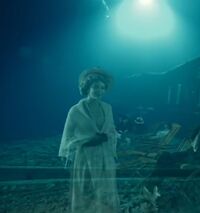Helen Churchill Candee was a First Class passenger of the Titanic. She survived the sinking.
Early Life[]
She was born as Helen Churchill Hungerford, in New York City on 5 October 1859. She was the daughter of Henry Hungerford and Mary E. Churchill. She was educated in various private schools in New Haven and Norwalk, Connecticut. She married Edward Candee in in 1888 and they two children: Edith and Harold. It seems that he was abusive and abandoned her and the family, she had to vye for herself and take care of her children alone. Candee obtained a divorce in 1896, after a lengthy separation.
Career[]
Helen became an author and gave lectures on the Liberal Arts and the Orient. This is her most notable bibliography:
- Susan Truslow (1900)
- An Oklahoma Romance (1901)
- How Women May Earn a Living (1900)
- Decorative Styles and Periods (1906)
- The Tapestry Book (1912)
- Angkor, The Magnificent (1924)
- New Journeys In Old Asia (1927)
- Weaves and Draperies (1931).
She was decorated by the government of French-Indo China in 1929 and was a member of the India Society of London as well as the Les Amis de l'Orient of Paris.
Aboard the Titanic[]
Candee was traveling in Europe in the spring of 1912, completing research for The Tapestry Book, when she received a telegram from her daughter, Edith, advising that Candee's son, Harold ("Harry"), had been injured in an accident. From Paris, Candee hurriedly booked passage home on the new luxury ocean liner, the RMS Titanic.
Mrs. Candee boarded the Titanic at Cherbourg as a First Class passenger. She was traveling to Washington DC. She was an attractive widow, espcially for her age of 52, and Archibald Gracie had a special attention for her. Whilst under the unofficial protection of Mr. Gracie, she socialized with other prominent travelers, such as President Taft's military aide, Major Archibald Butt and the painter Francis Davis Millet.
After the ship had struck an iceberg on the night of April 14th, it became apparant that they had to evacuate. Hugh Woolner literally stormed to her cabin to come and fetch her. He helped with her lifejacket and guided her up on deck. She was rescued in lifeboat 6. She had given an antique cameo of her mother to Edward Austin Kent for safekeeping as she thought he would have a better chance of surviving the sinking than she did. Although Mr. Kent died, his body was recovered and the cameo was found in his clothing and returned to Mrs. Candee.
Later life[]
Candee's Titanic injury required her to walk with a cane for almost a year, but by March 1913, she was able to join other feminist equestriennes in the "Votes for Women" parade down Pennsylvania Avenue (Washington, D.C.), riding her horse at the head of the procession that culminated at the steps of Capitol Hill.
During World War I, Candee worked as a nurse in Rome and Milan under the auspices of the Italian Red Cross, which decorated her for her service. One of her patients in Milan was Ernest Hemingway.
After the war, she traveled to Japan, China, Indonesia, and Cambodia, and her adventures became the basis for two of her most celebrated books: Angkor the Magnificent (1924) and New Journeys in Old Asia (1927). Candee was honored by the French government and the King of Cambodia for these works; she was also commanded to give a reading of Angkor to King George V and Queen Mary at Buckingham Palace.
Helen Candee, son Harry, their guide, and "Effie" the elephant at Angkor Wat (1922) Angkor the Magnificent was the first major English-language study of the ruins of the ancient Khmer temple Angkor Wat and its environs. Called the "Lost City" or the "Wonder City", Angkor Wat is considered one of the great man-made wonders of the world. Largely unknown to Westerners until the publication of Candee's book, its subsequent popularity laid groundwork for the modern tourist market in Cambodia.
On Candee's initial southeast Asian trips in 1922-23 she was accompanied by her son, Harry, with whom she trekked through the then dangerous jungles with their native guide, riding atop the great elephant she named "Effie". On later visits, the author was joined by her friend and collaborator, illustrator Lucille Douglas. Although The Tapestry Book was the most lucrative book Candee wrote, Angkor the Magnificent was the most acclaimed.
The success of Angkor and New Journeys led to a prosperous secondary career for Candee as a lecturer on the Far East, while her work as a journalist continued apace. She was briefly Paris editor for Arts & Decoration (1920–21) and remained on that publication's editorial advisory staff for several years
In 1925, Candee was among the nine founding members of the Society of Woman Geographers. As late as 1935 or 1936, when she was almost 80, Candee was still traveling abroad, writing articles for National Geographic magazine. Her first books on interior design, The Tapestry Book and Decorative Styles and Periods, were re-released in 1935 and 1938 respectively, the former in a collectible boxed issue.
Mrs Candee died in York, York County, Maine on 23 August 1949, and was buried in York at the First Parish Cemetery.
After her death[]
Titanic-related items belonging to Helen Candee, including a flask and a locket she carried with her on board, were auctioned for record sums in 2005-06. Letters and the manuscript thought to have inspired Cameron were also sold by Candee's family at this time. In 2007, Helen Candee's former Washington home at 1621 New Hampshire Avenue was acquired by The Fund for American Studies. In 2008, her Angkor the Magnificent was re-released in a special edition that includes a new foreword and a biographical profile. In 2009, the newly appointed Ambassador to Cambodia, Carol Rodley, presented a copy of the reissued Angkor as a protocol gift to King Norodom Sihamoni on her arrival at the palace in Phnom Penh, Khmer.
Portrayals[]
Ghosts of the Abyss (2003)[]

Adrianna Valez as Helen Candee in Ghosts of the Abyss
| “ |
Helen Candee is one of my favorite passengers. She had written one of the century's first best sellers. Basically, the theme being how a woman can get along in life successfully without a man. And that's how she was traveling first-class on the Titanic. And on the very last sunrise that the Titanic would ever see, she snuck out to the very point of the bow just to greet the sunrise alone. And she wrote about it and how she felt the power and the beauty of this ship and that it was stronger than nature itself, maybe even stronger than God itself. And then, suddenly, she felt very darkened, as if she had thought something sacrilegious. |
” |
—Bill Paxton | ||
Helen Churchill Candee was portrayed by Adrianna Valez in Ghosts of The Abyss (2003).

A flashback scene of Helen Candee in the bow
Bill Paxton commented that Helen Candee was one of his favorite passengers, and mentioned Helen's experience sneaking to the Titanic's bow for some fresh air.
